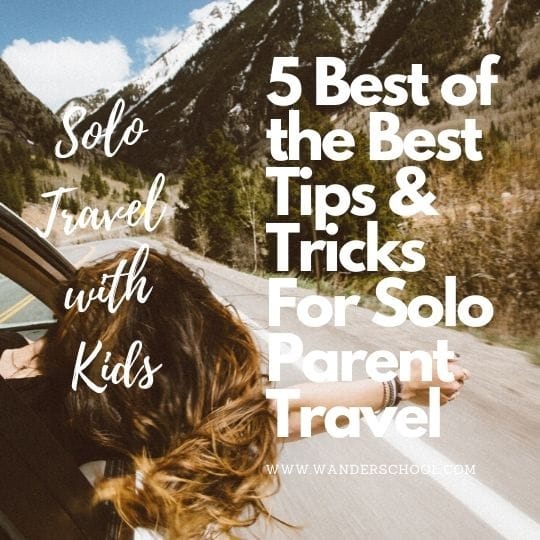Winter Hiking with Kids may sound daunting, but these 10 Tips for Winter Hiking with Kids will maximize the chances that you’ll have a positive experience.
Kids love snow and playing in it, so winter hiking with kids makes for a fun adventure.
Affiliate Links Disclosure: My posts sometimes contain affiliate links, which mean that if you click on them and make a purchase or sign up for an offering, I may earn a commission, at no added cost to you. I received no compensation for writing this post, and it reflects my own experiences, research, and opinions. You can read my my privacy policy here. Thank you so very much for reading my blog!
Winter Hiking with Kids
Hiking with kids can be so much fun. Some of my favorite times and memories with my children are from our hiking adventures together, like hiking through a snow field during the Tour du Mont Blanc or snowshoeing in the French Alps.
I hope this guide and top tips for winter hiking with children will inspire you to spend more time with your family outside this winter.
Top 10 Tips for Winter Hiking with Children
1. Wear the Right Stuff.
Sounds simple enough, right? Well, not so fast. It’s essential to wear the right stuff when you go hiking, especially winter hiking. The right winter clothing means wearing layers that are appropriate for your adventure. It also means packing along winter clothes or cold weather accessories, like extra gloves, for just in case.
All layers and clothing are not created equally. The right stuff means synthetic layers. You’ll want to be able to add layers or shed layers, depending on the temperature, what the weather is doing, and your activity level (a.k.a. speed) while winter hiking. Whether you end up hiking far or spending most of your time standing around throwing snowballs, you’ll want to dress warmly and be prepared for inclement weather, and weather shifts or changes.
2. Bring the Right Gear.
When you are winter hiking, there is less room for error on the trails. That means, you need to show up at the trailhead with the right gear appropriate for the outing, intended trip duration, your children’s abilities (and yours), and weather.
For example, if you’re hiking with a toddler, you may wish to bring a kid hiking backpack or baby carrier. You can find deals on backpacks or kid-carriers suitable for hiking with kids online, including used gear such as on Facebook Marketplace, Craigslist, or Leboncoin (depending on where you are located on this big, beautiful planet).
If there’s fresh snow, you might want to consider snowshoes. You can find awesome snowshoes for tiny feet, too. My kids grew up playing and hiking in Tubbs and Redfeather snowshoes.
You might also want to consider spikes (sometimes called cleats or crampons) for your hiking shoes or boots, especially if the trail is slick. You can find inexpensive microspikes online and sometimes at big stores like Costco.
Remember, too, that just because it’s winter, you may still need sun protection and sunglasses. Snow reflects the sun’s rays (like a mirror), and therefore, exposure to sun in winter, even if there’s not a lot of sun and you’re only trudging through snow, can actually be serious. So, take precautions and be prepared.
Other gear you may need for winter hiking:
- waterproof, insulated hiking boots
- winter gaiters
- gloves or mittens
- synthetic hat (no cotton!)
3. Bring the Essentials.
In addition to wearing the right clothing and bringing the right gear, you’ll want to pack along the essentials. These essentials are essentials for winter hiking, regardless of the time of day you plan to hike or the duration of the trip. Yes, you should bring essentials even if you only plan to be out a short time.
Winter hiking essentials include, but aren’t limited to:
- emergency blanket or emergency BIVY sack (bring at least one for each person)
- cell phone
- first aid kit
- heat packs
- high-energy or calorie food or snacks
- water
- headlamp
- lighter
- whistle
- map / compass
- hand sanitizer
- toilet paper
- water filtration system, like a LifeStraw, or iodine water purification tablets
4. Communicate Your Plans.
Let someone you trust know your hiking plans before you set off onto the trail. Giving someone your details like where you’re going, how long you expect to be out, and letting them know when you’re off the trail is a good idea, whether you’re hiking with kids or not.
Also, assuming you are within cell phone range, it can be a good idea to text that person (or anyone else you trust) where you are from time-to-time on the trail or when you’ve hit your turnaround point.
5. Make it Fun.
Bring a thermos with hot chocolate. Bring yummy treats.
Or bring an unusual snack. It’s sure to be a memorable hit. For example, my kids think bringing a baked potato wrapped in aluminum foil is hilarious (a.k.a. ridiculous), however, they love peeling back the foil and eating one mid-hike.
Also consider bringing a cheap, ultralight weight sled that can tie onto your backpack, like this kind of portable sled, or a portable carpet sled. Sure, butt sliding down a trail or mountain is fun during the winter, but a sled is wayyyyy cooler.
Play games along the way, too. Like the classic, I Spy. Or create an on-the-fly treasure hunt, like “who can find a pinecone first.”
6. Stay Flexible.
Winter hiking is the time to practice flexibility and to go with the flow. Think of the saying you’re only as fast as your slowest person. There is no prize for getting somewhere fastest or first when you’re out for a family winter hike.
Be willing to adjusting your plan. And willing to adjust your expectations. This includes be willing to call the hike quits, even if you’ve only been out there a short time.
Oh, and don’t lose your cool! Stay patient and keep perspective of why you are outside together. Being together and enjoying a positive experience together, even if it’s a shorter or different experience than envisioned, is worth far more than sharing a stressful experience.
7. Know Your Kids.
Of course you know your kids, but when it comes to winter hiking you really need to tune into your kids. Tune into their limitations, strengths, and moods. Also, tune into the signs that they show directly or subtly that enough is enough.
You can build up your kids’ stamina and distance over time, so don’t expect too much from a single hike, especially if it is a first winter hike or early on in the winter season.
8. Tend to Problems Right away.
Trouble shoot issues early on and don’t let issues fester. This is especially important during winter hiking with kids.
For example, if a child starts complaining that his or her hands are cold, check to see if mittens are still dry and whether the core is bundled up, zipped up, or needs another layer. If a kiddo complains he or she is tired, think about whether the distance is enough already, the terrain too difficult (especially if they are bundled up more than usual and trudging through snow, even on a familiar trail), or if snacks are needed.
If a kid says they have to pee, but doesn’t want to because they’ll be too cold to do so, consider that hiking around with a full bladder could actually make your kid cold.
9. Check and Double Check the Weather and Trail Conditions Before You Go.
In winter, it’s especially important to check the weather and double check it before you go. It’s also important to know your trail. What are the current trail conditions? Are there any new dangers that you should be aware of or which should alter your plans. For example, is there a wind chill warning, approaching storm warning, or avalanche warning?
10. Hike with Others
Hiking with other families can potentially make winter hiking more fun, safer, and keep your kids enthusiastic and motivated to keep moving and playing. At the end of the day, you want your kid to be psyched to do it all again. So, if going along with friends makes winter hiking merrier, then perhaps the more the merrier. 😉
Of course, going with other families also means extra hands to help you out. This can be helpful when you’re outside and negotiating a winter adventure with kids.
How to Find Winter Hiking Trails Near You
You can find winter hiking trails near you by asking around locally. Inquire about the best or easy local hikes in your community at local sports shops or hiking clubs. You can also find hiking or walking groups on Facebook, as well as parenting groups in your area. You can also buy hiking with kids guidebooks for your area. For example, if you’re in the New England region of the USA, you can find books like Best Hikes for Kids in Vermont, New Hampshire and Maine. There are also hiking apps that can help you find and plan routes.
Frequently Asked Questions (FAQs)
Can I go winter hiking with a toddler (or hiking with an 18 month old)? Yes, see tips above. Keep the hike reasonable for a child’s age, the weather, brings snacks and extra layers, and be ready to turn back at anytime. Oh, and keep your expectations low!
For general information on how to start hiking, read How to Start Hiking: A Beginner’s Guide
How do you gain winter skills and backcountry readiness? Consider taking winter and outdoor courses led by experts, reading books, reading blog posts, and watching videos. There are so many incredible courses out there that can help you build confidence and prepare you for winter adventures, from winter survival courses, to wilderness first aid, to avalanche safety training. Consider taking a family course together to maximize outdoor fun!
Follow Julie on Social Media! 😉
Drop a comment. I’d love to hear your thoughts on these winter hiking tips with children.
Subscribe to the Wanderschool Newletter. Get the latest travel news delivered right to your inbox.





Anytime we hike with our kids, it is essential to have the right gear, enough snacks, and friends to hike with. Those are our 3 must-haves so that we don’t have our kids complaining the entire time. We still have to force them, but they always have fun while we are there. Great post.